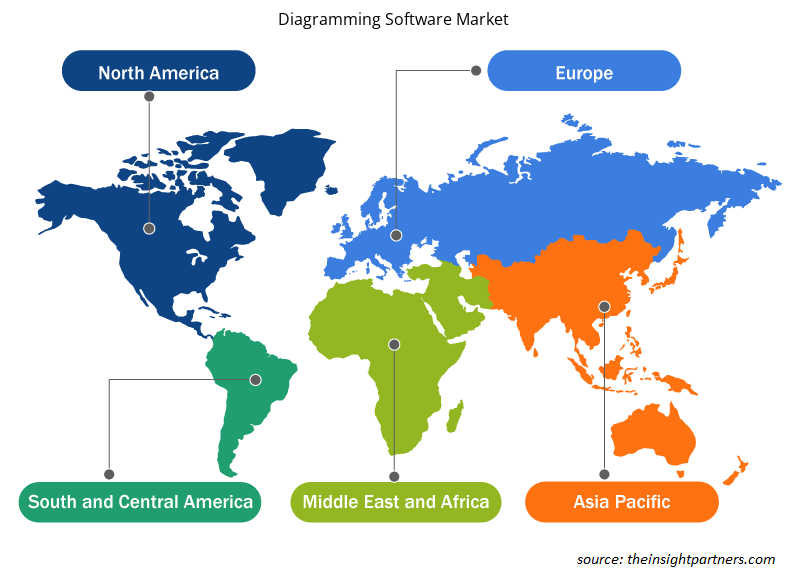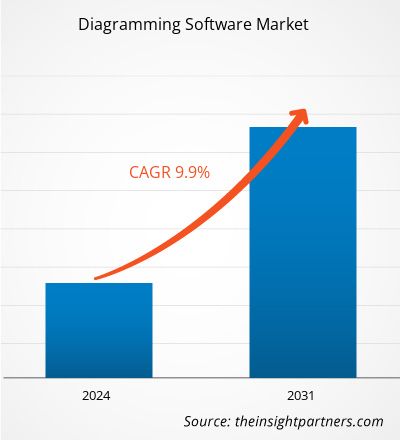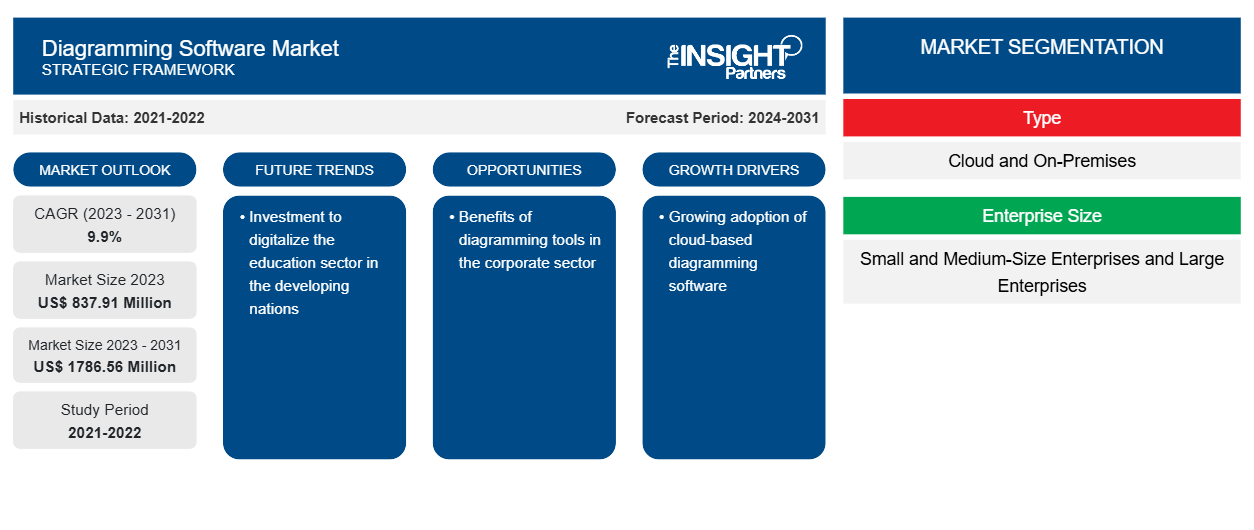图表软件市场规模预计将从 2023 年的 8.3791 亿美元增至 2031 年的 17.8656 亿美元。预计 2023-2031 年期间,该市场的复合年增长率将达到 9.9%。数字化的兴起和基于云的图表软件的日益普及可能仍是市场的主要趋势。
图表软件市场分析
由于大型企业和中小型企业的采用率不断提高,图表软件市场正在获得关注。采用这种软件有助于他们更好地定义业务环境中的工作流程和操作。组织的各个部门(例如营销、人力资源、工程和运营)都可以广泛使用它。
图表软件市场概览
借助图表软件,用户可以根据数据集和图像创建详细图表,包括流程图、饼图、平面图和其他图表。图表软件包含各种模板,可帮助用户从头开始创建图表。该软件可以轻松与其他工具和平台集成,多个用户可以查看并参与创建图表。
定制此报告以满足您的需求
您可以免费定制任何报告,包括本报告的部分内容、国家级分析、Excel 数据包,以及为初创企业和大学提供优惠和折扣
-
获取此报告的关键市场趋势。这个免费样品将包括数据分析,从市场趋势到估计和预测。
图表软件市场驱动因素和机遇
图表工具在企业领域的优势
图表有助于降低沟通的复杂性。在商业环境中,图表为业务流程提供了清晰简洁的视觉表示。它有助于所有员工了解项目实施中需要遵循的目标和流程。通过采用图表工具,团队负责人或项目经理可以将项目工作流程传达给员工,并用图表进行解释。图表软件可帮助他们创建饼图、流程图和其他几种模板化图表。项目或业务目标的视觉表示有助于员工更好地了解项目的趋势和范围。因此,企业正在广泛采用图表软件。
采用基于云的软件
由于发达国家和发展中国家的工业化和全球化举措不断推进,各行各业的商业活动都在增长。此外,据观察,企业正在采用数字化转型来获得竞争优势并最大限度地提高生产力。为此,企业正在寻找一种经济高效的解决方案,这导致企业采用基于云的图表软件解决方案。
图表软件市场报告细分分析
有助于图表软件市场分析的关键部分是部署类型、企业规模和应用程序。
- 根据部署类型,图表软件市场分为云和本地。2023 年,本地部分占据了最大的市场份额。
- 根据企业规模,市场分为中小型企业和大型企业。预计中小型企业板块的复合年增长率最高。
- 根据企业规模,市场分为教育机构、企业和个人。教育机构部门在 2023 年占据了相当大的市场份额。
图表软件市场份额按地区分析
图表软件市场报告的地理范围主要分为五个区域:北美、亚太、欧洲、中东和非洲、南美和中美。
亚太地区占据最大的市场份额,预计将以最高的复合年增长率增长。印度、日本和中国等国家占据了亚太地区的大部分市场份额。日益增长的数字化是导致采用数字解决方案的主要因素之一。发展中国家日益增长的电子学习平台和日益增长的中小企业正在推动图表软件解决方案的采用。
图表软件市场区域洞察
Insight Partners 的分析师已详尽解释了预测期内影响图表软件市场的区域趋势和因素。本节还讨论了北美、欧洲、亚太地区、中东和非洲以及南美和中美洲的图表软件市场细分和地理位置。

- 获取图表软件市场的区域特定数据
图表软件市场报告范围
| 报告属性 | 细节 |
|---|---|
| 2023 年的市场规模 | 8.3791亿美元 |
| 2031 年市场规模 | 17.8656亿美元 |
| 全球复合年增长率(2023 - 2031) | 9.9% |
| 史料 | 2021-2022 |
| 预测期 | 2024-2031 |
| 涵盖的领域 |
按类型
|
| 覆盖地区和国家 |
北美
|
| 市场领导者和主要公司简介 |
|
图表软件市场参与者密度:了解其对业务动态的影响
图表软件市场正在快速增长,这得益于最终用户需求的不断增长,而这些需求又源于消费者偏好的不断变化、技术进步以及对产品优势的认识不断提高等因素。随着需求的增加,企业正在扩大其产品范围,进行创新以满足消费者的需求,并利用新兴趋势,从而进一步推动市场增长。
市场参与者密度是指在特定市场或行业内运营的企业或公司的分布情况。它表明在给定市场空间中,相对于其规模或总市场价值,有多少竞争对手(市场参与者)存在。
图表软件市场的主要公司有:
- Creately
- draw.io
- Perforce 的 Gliffy
- 亿图软件
- Lucidchart
- 微软
免责声明:上面列出的公司没有按照任何特定顺序排列。

- 获取图表软件市场顶级关键参与者概览
图表软件市场新闻和最新发展
图表软件市场通过收集一手和二手研究后的定性和定量数据进行评估,其中包括重要的公司出版物、协会数据和数据库。图表软件市场的一些发展如下所列:
- 谷歌推出了全新的 Google Cloud 架构图表工具。该工具使用户能够与团队分享愿景、与他们协作、迭代设计并创建最符合业务用例要求的最终版本。(来源:谷歌,新闻稿,2022 年 2 月)
- 领先的图表软件 EdrawMax 推出了其移动版本 EdrawMax App,旨在让用户轻松创建专业的流程图和框图。新应用程序提供了 20,000 多个高质量图表模板,用户可以自定义和修改这些模板以创建精美的图表,从而提高工作效率并节省用户时间。(来源:PRNewswire,新闻稿,2023 年 4 月)
图表软件市场报告覆盖范围和交付成果
“图表软件市场规模和预测(2021-2031)”报告对市场进行了详细的分析,涵盖以下领域:
- 图表软件市场规模及全球、区域和国家层面所有主要细分市场的预测
- 绘制软件市场趋势图以及市场动态,如驱动因素、限制因素和关键机遇
- 详细的 PEST/波特五力分析和 SWOT 分析
- 图表软件市场分析涵盖主要市场趋势、全球和区域框架、主要参与者、法规和最新市场发展
- 行业格局和竞争分析,涵盖市场集中度、热图分析、知名参与者以及图表软件市场的最新发展
- 详细的公司简介
- 历史分析(2 年)、基准年、预测(7 年)及复合年增长率
- PEST和SWOT分析
- 市场规模、价值/数量 - 全球、区域、国家
- 行业和竞争格局
- Excel 数据集
近期报告
相关报告
客户评价
购买理由
- 明智的决策
- 了解市场动态
- 竞争分析
- 客户洞察
- 市场预测
- 风险规避
- 战略规划
- 投资论证
- 识别新兴市场
- 优化营销策略
- 提升运营效率
- 顺应监管趋势























 获取免费样品 - 图表软件市场
获取免费样品 - 图表软件市场